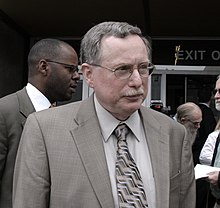Mark Klein
Mark Klein is an American whistleblower and former AT&T communications technician who disclosed information about his former employer's cooperation with the National Security Agency (NSA) in 2006 . The revelations Klein met by the EFF out class action , which was dismissed, however, 2009 citing the the FISA Amendments Act of 2008 granted retroactive immunity for telecommunications companies that cooperate with the state.
Life
Mark Klein worked for AT&T for 22 years. He started working for the company as a Communications Technician in New York from November 1981 and stayed in this position until March 1991. He later worked in the same department in California. From January 1998 to October 2003, Klein worked as a Computer Network Associate in San Francisco. From October 2003 to March 2004 he worked again as a communications technician and retired in May 2004.
Klein's revelations
Klein had discovered that the NSA connected to a central line of the Internet service provider AT&T by means of a splitter and that all data traffic was diverted to eavesdropping devices from Boeing subsidiary Narus . This makes deep packet inspection possible. The program became known under the name Room 641A . The data interception system was installed in this real room in the SBC Communications Building at 611 Folsom Street, San Francisco . The room was approximately 7.3 by 14.6 m and contained a number of racks, etc. a. a Narus STA 6400 , a device whose job is to intercept and monitor high-speed Internet communication. This is how the NSA intercepted digital communications at some nodes between 2003 and 2006. Klein decided to make his discovery public because this extensive, indiscriminate interception of domestic traffic contradicted President Bush's claim that the NSA was only collecting phone calls with terrorist suspects abroad.
Former director of the NSA's World Geopolitical and Military Analysis Reporting Group, William Binney , confirmed that 10 to 20 systems like those in Room 641A were installed across the United States.
The American activist Jacob Appelbaum wrote in July 2013 after the Snowden revelations on the NSA's global surveillance and espionage affair : "The information that Klein revealed was downplayed, and it was an important example of the NSA's extensive espionage program."
Web links
- ABC Nightline Interview with Klein
- Klein's memo about the NSA program ( Memento from June 3, 2006 in the Internet Archive ; PDF; 1.7 MB)
- Whistle-Blower's Evidence, Uncut. In: Wired 2006
- Whistleblower Mark Klein . PBS NOW , February 2007
- For Your Eyes Only? PBS NOW , February 2007
- Spying On The Home Front . PBS frontline
- First interview with the NSA whistleblower on EFF
- Wiring Up the Big Brother Machine… And Fighting It by Mark Klein
- Interview with Klein. Wired (2008)
Individual evidence
- ↑ The NYT had already reported on telephone surveillance in 2005: Bush Lets US Spy on Callers Without Courts
- ↑ Klein's Declaration (unredacted) , from the case Hepting v. AT&T - Electronic Frontier Foundation (June 8, 2006)
- ↑ Christoph Dernbach: How the secret services monitor Internet data . In: impulse , June 27, 2013
- ↑ Ellen Nakashima: A Story of Surveillance . In: Washington Post . November 7, 2007.
- ↑ "We are all vulnerable" . In: Der Spiegel . No. 28 , 2013, p. 24 ff . ( online ).
| personal data | |
|---|---|
| SURNAME | Small, Mark |
| BRIEF DESCRIPTION | American whistleblower |
| DATE OF BIRTH | 20th century |
